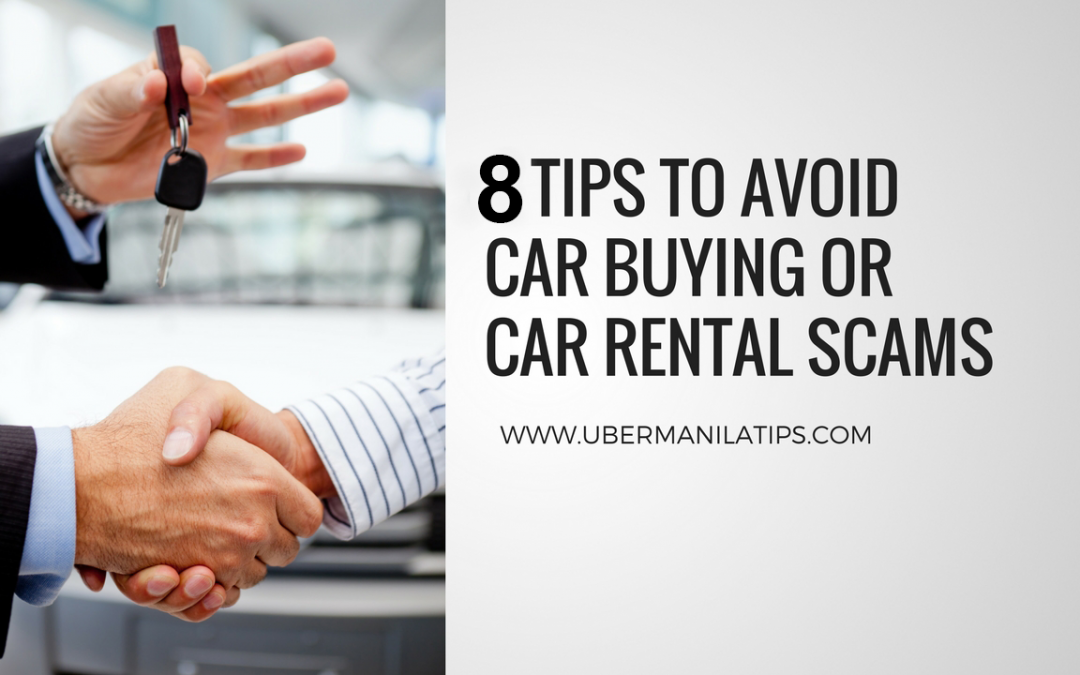About a few months ago, there was a “rent-sangla” scam going around. More than 60 victims trooped to the Department of Justice (DOJ) to file their cases against a syndicate that allegedly sold rented cars to them and ran away with their money.
Rideshare operators (be it Uber or Grab) looking for extra rental income to augment their vehicle’s monthly amortization became a target of these shady individuals who pose as private car renter. These “car renters” either sell, or lease the car to someone else, or make the car a collateral of some sort which they don’t have the authority to do since they are not the official owners of the car.
So, we need to know how to protect ourselves; be it they rent the car from us or we are offered a “too-good-to-be-true” deal to buy a car. Here are some tips from the online car platform Carmudi to prevent being a victim of these scams.
Tips for car owners and rideshare operators:
- Look for signs of a legitimate rental. Ask if you can see the garage where they dispatch the vehicles. If you have your own driver, ask them if your trusted driver can drive instead. Double check with friends if they’ve heard about the car rental company. You might also want to check if their corporate clients actually engage and avails of car rental services.
- Install GPS Tracking Device in your vehicle. Prevention is better than cure. Having a GPS tracking device installed in your vehicle is a good investment. So that if you’d want to check the location of your vehicle at any time. It’s good to take care of our assets, gives us peace of mind.
- Manage the risk. At the first sign of trouble, pull your vehicle out as soon as you smell something fishy. Don’t wait it out and “see” for another week or another month. Listen to your gut instinct.
Tips for Car Buyers:
4. Know the actual price of the vehicle. Scammers often use low prices to entice victims. If the price of the vehicle seems too low in comparison to what the typical value of that make and model is, then you’ll want to know the reason behind this. If you can’t verify the reason, or if there’s something off about it, it may be better for you to walk away from the sale. Remember, there’s always another car out there that can suit your needs just fine.
5. Verify the seller’s and the car’s identity. Ask the seller for proof of identity. Make sure it’s a government-issued ID, such as a Social Security card or driver’s license. Check that the seller’s name and address match what’s printed on the vehicle registration form. As well, make sure you’re looking at the original registration form and not just a copy. With the registration form, compare the make, model, year, and vehicle identification number (VIN) of the car with what’s on paper. Check for evidence of tampering.
6. Never use wire transfers for payments. Legitimate car sellers will never use wire transfer. If you’re dealing with a private seller and they insist that you use a wire transfer service such as Western Union or MoneyGram, ask to use another mode of payment—preferably one where proof of identification is necessary. Scammers love using wire transfers because these services often have lenient application processes, making them difficult to trace. Once the money disappears, you won’t be able to recover it.
7. Use anti-stolen car tools. You may hold the keys in your hands and have the paperwork stating you’re the vehicle’s registered owner, but none of these confirm that the law supports your car ownership. If the car is stolen, technically, it still belongs to the original owner. You can find out if a vehicle is stolen by texting its plate number to the Land Transportation Office (LTO) SMS service.. After the LTO’s computers check out their database, you’ll have your information. Another tool that you can use is the Highway Patrol Group’s (HPG) Facebook account. Since August 2015, each of the HPG’s regional units have beenusing their Facebook accounts to post information on the vehicles they recovered. Though it certainly takes time and effort to sift through the pictures, it’s time well spent as long as you avoid purchasing a stolen car.
Just text LTO VEHICLE (insert vehicle plate number here) then send to 2600
8. Take the vehicle for a pre-purchase inspection. When you get the chance to inspect the vehicle, do so thoroughly to make sure everything is in good working condition. The true owner of the vehicle will know which parts are malfunctioning or broken, so if he’s just as surprised as you that the electric window won’t budge, start being wary. Get an independent mechanic to give the vehicle a detailed inspection. When taking the car out for a test drive, take at least 15 to 30 minutes to accurately gauge how well the vehicle runs. Offer to pay the gas if you have to.
Do you have any other anti-car buying scam tips that you can share with us? Let us know in the comments section below.
Hope this article helped. Let us know in the comments sections if you have any questions or suggestions. You can also reach us at info@ubermanilatips.com. We would love to hear from you!
Don't forget to Like UberMNLTips on Facebook and subscribe to our blog for more practical tips and latest updates and promos!


